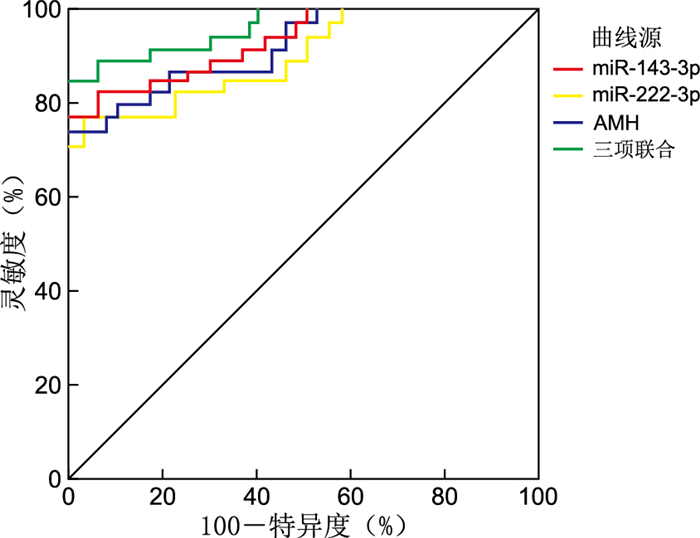Detection and clinical value of serum levels of miR-143-3p, miR-222-3p and AMH in patients with polycystic ovary syndrome
-
摘要:
目的 探讨血清miR-143-3p、miR-222-3p水平联合抗苗勒管激素(AMH)在多囊卵巢综合征(PCOS)中的表达及临床价值。 方法 选取2018年1月—2022年3月三亚市妇女儿童医院收治的128例PCOS患者(PCOS组)和50例健康女性(对照组)。PCOS患者根据胰岛素抵抗指数(HOMA-IR)分为胰岛素抵抗组(83例,HOMA-IR≥2.69)和非胰岛素抵抗组(45例,HOMA-IR<2.69);根据BMI分为肥胖组(40例,BMI≥28)和非肥胖组(88例,BMI<28);根据睾酮水平分为高雄激素组(71例,睾酮≥0.7 ng/mL)及非高雄激素组(57例,睾酮<0.7 ng/mL)。采用实时定量PCR法检测血清miR-143-3p及miR-222-3p水平和电化学发光法检测AMH水平。ROC曲线分析miR-143-3p、miR-222-3p联合AMH对PCOS的诊断价值。相关性分析采用Pearson相关分析。 结果 PCOS组血清miR-143-3p、miR-222-3p及AMH水平均明显高于对照组,肥胖组明显高于非肥胖组,高雄激素组明显高于非高雄激素组,胰岛素抵抗组明显高于非胰岛素抵抗组,差异均有统计学意义(均P<0.001)。ROC曲线显示,miR-143-3p、miR-222-3p及AMH三项联合诊断PCOS的曲线下面积最大(AUC=0.910,95% CI:0.852~0.974)。PCOS患者血清miR-143-3p、miR-222-3p水平与AMH均呈正相关关系(r=0.842、0.795,均P<0.001)。 结论 PCOS患者血清miR-143-3p、miR-222-3p及AMH水平明显升高,三项联合检测对PCOS诊断具有较高的价值。 -
关键词:
- 多囊卵巢综合征 /
- 微小核糖核酸-143-3p /
- 微小核糖核酸-222-3p /
- 抗苗勒管激素 /
- 诊断价值
Abstract:Objective To investigate the expression and clinical value of serum miR-143-3p, miR-222-3p levels combined with anti-Mullerian hormone (AMH) in polycystic ovary syndrome (PCOS). Methods Total 128 patients with PCOS (PCOS group) treated in Sanya Women and Children's Hospital from January 2018 to March 2022 and 50 healthy women (control group) were selected. According to insulin resistance index (HOMA-IR), PCOS patients were divided into insulin resistance group (n=83, HOMA-IR≥2.69) and non-insulin resistance group (n=45, HOMA-IR < 2.69). According to BMI, PCOS patients were divided into obesity group (n=40, BMI≥28) and non-obesity group (n=88, BMI < 28). According to the level of testosterone, they were divided into hyperandrogen group (n=71, testosterone≥0.7 ng/mL) and non-hyperandrogen group (n=57, testosterone < 0.7 ng/mL). The serum levels of miR-143-3p and miR-222-3p were detected by real-time quantitative PCR, and AMH was detected by electrochemiluminescence. The diagnostic value of miR-143-3p, miR-222-3p combined with AMH in PCOS were analyzed by receiver operating characteristic (ROC) curve. Pearson correlation analysis was used for correlation analysis. Results The serum levels of miR-143-3p, miR-222-3p and AMH in PCOS group were significantly higher than those in control group, those in obesity group was significantly higher than that in non-obesity group, those in hyperandrogen group was significantly higher than that in non-hyperandrogen group, and insulin resistance group was significantly higher than that in non-insulin resistance group, with statistical significance (all P < 0.001). ROC curve showed that the combined diagnosis of PCOS by miR-143-3p, miR-222-3p and AMH had the largest area under the curve (AUC=0.910, 95% CI: 0.852-0.974). The serum levels of miR-143-3p and miR-222-3p in PCOS patients were positively correlated with AMH (r=0.842, 0.795, all P < 0.001). Conclusion The serum levels of miR-143-3p, miR-222-3p and AMH were significantly increased in PCOS patients, and the detection of the three items were helpful for the diagnosis of PCOS. -
表 1 PCOS组和对照组临床资料比较(x±s)
Table 1. Comparison of clinical data between PCOS group and control group (x±s)
组别 例数 年龄(岁) BMI 腰围(cm) 臀围(cm) 收缩压(mm Hg) 舒张压(mm Hg) 对照组 50 28.95±4.12 23.37±2.45 72.40±8.27 86.35±5.34 116.83±12.26 71.42±7.68 PCOS组 128 29.72±4.83 23.84±2.62 75.93±9.05 89.16±7.18 119.40±12.53 74.25±9.46 t值 0.962 1.105 1.594 1.353 0.672 0.735 P值 0.328 0.264 0.152 0.176 0.479 0.430 组别 例数 空腹血糖(mmol/L) HOMA-IR LH(mIU/mL) FSH(mIU/mL) LH/FSH 睾酮(ng/mL) 对照组 50 5.20±0.53 1.76±0.45 5.63±0.64 8.74±0.90 0.62±0.07 0.47±0.14 PCOS组 128 5.74±1.65 4.60±2.57 8.40±0.75 6.91±0.38 1.26±0.15 1.77±0.38 t值 1.183 6.894 5.537 3.896 6.724 5.952 P值 0.241 <0.001 <0.001 0.012 <0.001 <0.001 注:1 mm Hg=0.133 kPa。 表 2 PCOS组和对照组血清miR-143-3p、miR-222-3p及AMH水平比较(x±s)
Table 2. Comparison of serum miR-143-3p, miR-222-3p and AMH levels between PCOS group and control group (x±s)
组别 例数 miR-143-3p miR-222-3p AMH(ng/mL) 对照组 50 0.91±0.24 0.68±0.15 3.38±1.35 PCOS组 128 2.96±1.17 1.73±0.66 9.86±2.74 t值 17.582 14.305 14.713 P值 <0.001 <0.001 <0.001 表 3 肥胖组、非肥胖组和对照组血清miR-143-3p、miR-222-3p及AMH水平比较(x±s)
Table 3. Comparison of serum miR-143-3p, miR-222-3p and AMH levels between obese group and non obese group (x±s)
组别 例数 miR-143-3p miR-222-3p AMH(ng/mL) 对照组 50 0.91±0.24 0.68±0.15 3.38±1.35 非肥胖组 88 1.16±0.35 0.75±0.20 4.20±1.46 肥胖组 40 4.85±1.63ab 2.79±1.08ab 15.58±5.24ab F值 21.152 16.625 19.583 P值 <0.001 <0.001 <0.001 注:与对照组比较,aP<0.001;与非肥胖组比较,bP<0.001。 表 4 高雄激素组、非高雄激素组和对照组血清miR-143-3p、miR-222-3p及AMH水平比较(x±s)
Table 4. Comparison of serum miR-143-3p, miR-222-3p and AMH levels between hyperandrogen group and non hyperandrogen group (x±s)
组别 例数 miR-143-3p miR-222-3p AMH(ng/mL) 对照组 50 0.91±0.24 0.68±0.15 3.38±1.35 非高雄激素组 57 1.83±0.71a 1.42±0.46a 7.30±2.17a 高雄激素组 71 4.06±1.45ab 2.02±0.84ab 12.69±4.18ab F值 19.216 14.973 19.542 P值 <0.001 <0.001 <0.001 注:与对照组比较,aP<0.001;与非高雄激素组,bP<0.001。 表 5 胰岛素抵抗组、非胰岛素抵抗组和对照组血清miR-143-3p、miR-222-3p及AMH水平比较(x±s)
Table 5. Comparison of serum miR-143-3p, miR-222-3p and AMH levels between insulin resistance group and non insulin resistance group (x±s)
组别 例数 miR-143-3p miR-222-3p AMH(ng/mL) 对照组 50 0.91±0.24 0.68±0.15 3.38±1.35 非胰岛素抵抗组 45 1.79±0.68a 1.38±0.43a 7.60±2.24a 胰岛素抵抗组 83 4.13±1.47ab 2.10±0.86ab 12.42±4.13ab F值 20.763 15.810 16.284 P值 <0.001 <0.001 <0.001 注:与对照组比较,aP<0.001;与非胰岛素抵抗组,bP<0.001。 表 6 血清miR-143-3p、miR-222-3p及AMH水平对PCOS的诊断价值
Table 6. Diagnostic value of serum levels of miR-143-3p, miR-222-3p and AMH in PCOS
项目 最佳截断值 AUC 95% CI 灵敏度(%) 特异度(%) 阳性预测值(%) 阴性预测值(%) miR-143-3p 2.04 0.834 0.776~0.895 85.8 80.2 83.5 82.4 miR-222-3p 1.28 0.787 0.731~0.850 81.6 74.8 72.0 79.5 AMH(ng/mL) 6.97 0.814 0.755~0.871 83.5 76.0 79.2 80.8 三项联合 0.910 0.852~0.974 96.0 78.7 83.0 92.4 -
[1] STENER-VICTORIN E, DENG Q L. Epigenetic inheritance of polycystic ovary syndrome-challenges and opportunities for treatment[J]. Nat Rev Endocrinol, 2021, 17(9): 521-533. doi: 10.1038/s41574-021-00517-x [2] SADEGHI H M, ADELI I, CALINA D, et al. Polycystic ovary syndrome: A comprehensive review of pathogenesis, management, and drug repurposing[J]. Int J Mol Sci, 2022, 23(2): 583. doi: 10.3390/ijms23020583 [3] 王昱欢, 丁奕岑, 蔡瑶雨, 等. 差异表达微RNA作为多囊卵巢综合征生物标志物的研究[J]. 上海交通大学学报(医学版), 2021, 41(11): 1429-1435. doi: 10.3969/j.issn.1674-8115.2021.11.005WANG Y H, DING Y C, CAI Y Y, et al. Study on differentially expressed microRNA as a biomarker of polycystic ovary syndrome[J]. Journal of Shanghai Jiaotong University (Medical Edition), 2021, 41(11): 1429-1435. doi: 10.3969/j.issn.1674-8115.2021.11.005 [4] CAO J P, HUO P, CUI K Q, et al. Follicular fluid-derived exosomal miR-143-3p/miR-155-5p regulate follicular dysplasia by modulating glycolysis in granulosa cells in polycystic ovary syndrome[J]. Cell Commun Signal, 2022, 20(1): 61. doi: 10.1186/s12964-022-00876-6 [5] YE H, LIU X J, HUI Y, et al. Downregulation of microRNA-222 reduces insulin resistance in rats with PCOS by inhibiting activation of the MAPK/ERK pathway via pten[J]. Mol Ther Nucleic Acids, 2020, 22(7): 733-741. [6] 秦薇, 黄筱竑, 黄慧莲. HIF-1α、VEGF及AMH在多囊卵巢综合征中的表达及其临床意义[J]. 中华全科医学, 2021, 19(10): 1693-1696. doi: 10.16766/j.cnki.issn.1674-4152.002144QIN W, HUANG X H, HUANG H L. Expression and clinical significance of HIF-1α, VEGF and AMH in patients with polycystic ovary syndrome[J]. Chinese Journal of General Practice, 2021, 19(10): 1693-1696. doi: 10.16766/j.cnki.issn.1674-4152.002144 [7] 中华医学会妇产科学分会内分泌学组及指南专家组. 多囊卵巢综合征中国诊疗指南[J]. 中华妇产科杂志, 2018, 53(1): 2-6. https://www.cnki.com.cn/Article/CJFDTOTAL-SFCZ201810010.htmEndocrinology group and guideline expert group of Obstetrics and Gynecology branch of Chinese Medical Association. Chinese guidelines for diagnosis and treatment of polycystic ovary syndrome[J]. Chinese Journal of Obstetrics and Gynecology, 2018, 53(1): 2-6. https://www.cnki.com.cn/Article/CJFDTOTAL-SFCZ201810010.htm [8] FAROOQUI N, MAHA Q U. Role of some MiRNA affecting polycystic ovarian syndrome and SIRT1 levels[J]. J Pak Med Assoc, 2020, 70(5): 945. [9] WANG W, JI J, LI J, et al. Several critical genes and microRNAs associated with the development of polycystic ovary syndrome[J]. Ann Endocrinol (Paris), 2020, 81(1): 18-27. doi: 10.1016/j.ando.2019.10.002 [10] 杨东霞, 申儒霞, 李红梅, 等. 微小RNA在多囊卵巢综合征发病机制中的研究进展[J]. 中国生育健康杂志, 2022, 33(1): 81-83, 89. https://www.cnki.com.cn/Article/CJFDTOTAL-SYJK202201021.htmYANG D X, SHEN R X, LI H M, et al. Research progress of microRNA in the pathogenesis of polycystic ovary syndrome[J]. Chinese Journal of Reproductive Health, 2022, 33(1): 81-83, 89. https://www.cnki.com.cn/Article/CJFDTOTAL-SYJK202201021.htm [11] BUTLER A E, RAMACHANDRAN V, HAYAT S, et al. Expression of microRNA in follicular fluid in women with and without PCOS[J]. Sci Rep, 2019, 9(1): 16306. DOI: 10.1038/s41598-019-52856-5. [12] DU J, RUAN X Y, JIN F Y, et al. Abnormalities of early folliculogenesis and serum anti-müllerian hormone in chinese patients with polycystic ovary syndrome[J]. J Ovarian Res, 2021, 14(1): 36. doi: 10.1186/s13048-021-00786-0 [13] ZHAO Y Y, PAN S H, LI Y Y, et al. Exosomal miR-143-3p derived from follicular fluid promotes granulosa cell apoptosis by targeting BMPR1A in polycystic ovary syndrome[J]. Sci Rep, 2022, 12(1): 4359. DOI: 10.1038/s41598-022-08423-6. [14] HUANG X L, SHE L P, LUO X M, et al. MiR-222 promotes the progression of polycystic ovary syndrome by targeting p27 Kip1[J]. Pathol Res Pract, 2019, 215(5): 918-923. doi: 10.1016/j.prp.2019.01.038 [15] LI X J, WANG H, LU D Y, et al. Anti-müllerian hormone accelerates pathological process of insulin resistance in polycystic ovary syndrome patients[J]. Horm Metab Res, 2021, 53(8): 504-511. doi: 10.1055/a-1499-7718 [16] CHEN Z, OU H X, WU H L, et al. Role of microRNA in the pathogenesis of polycystic ovary syndrome[J]. DNA Cell Biol, 2019, 38(8): 754-762. doi: 10.1089/dna.2019.4622 [17] SHI X Y, PENG D, LIU Y F, et al. Advantages of serum anti-müllerian hormone as a marker for polycystic ovarian syndrome[J]. Lab Med, 2019, 50(3): 236-242. doi: 10.1093/labmed/lmy068 -





 下载:
下载:


